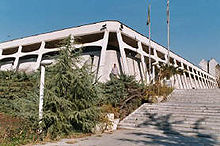Iranian Carpet Museum
The Iranian Carpet Museum , located next to Laleh Park in Tehran , shows Persian carpets from Iran from the 17th century to the present day.
founding
In 1976 the establishment of a carpet museum was tackled. Therefore, some of the qualified carpet experts have been sent to various cities and countries to acquire some pieces of precious carpets. Of course, this took some time, so that the current number was not yet available at the opening. The museum opened on February 12, 1978. The conception, the collection and the architectural design of the building go back to Schahbanu Farah Pahlavi . In 1978 Dr. Friedrich Spühler, former director of the Museum for Islamic Art (Berlin) , advisor to the Farah Diba Foundation in Tehran and helped set up the first Persian carpet museum. The pillars that support the roof structure of the museum are modeled on the warp and weft of a loom.
exhibition
The museum's exhibition area is 3400 m². It consists of two large halls for hand-knotted carpets and woven kilims . Usually there are 200 carpets in the exhibition, including the masterpieces of Persian carpets made in the main centers such as Kashan, Kerman, Isfahan, Tabriz, Khorasan and Kurdistan.
One of the oldest and most important carpets on display in this museum dates from the Safavid period and is called the "Sangeshku" carpet. Furthermore, seven animal carpets can be seen, the "Sheikh Safieddin Ardebili" carpet, garden carpets and Polish carpets, some of the most precious carpets that belong to this museum.
The carpets, which are known as "Polish carpets", were made in Isfahan in the 17th century on behalf of a Polish prince. The carpets were then brought to Poland and thus got their name. The material of these carpets was silk, which was dyed with natural colors and brocaded with gold and silver threads. About 300 carpets of this species have been identified and are scattered all over the world. Of these, seven have so far been returned to Iran.
The Pasyryk carpet found in 1949 in a Scythian grave in Siberia , whose origin dates back to 500 BC. BC, and which is considered to be the oldest Persian carpet in the world, can only be found as a re-knot in the Carpet Museum in Tehran - the original is in the Hermitage in St. Petersburg.
Some carpets contain pictures from Shahname and show the references of Persian carpets to Persian literature.
The library attached to the museum contains over 7000 books on carpets. It should be noted that there is a collection of the most valuable books, publications and research pieces on Persian carpets in the library, which are very precious. The library's holdings also contain films and slides about the manufacture of carpets and kilims.
To preserve the art of weaving kilims and knotting carpets, the museum offers a range of courses: from carpet weaving, designing patterns and repairing damaged carpets and kilims. At the end of these courses, the participants receive a recognized certificate. There is also a repair shop that repairs valuable carpets from their owners. This shop was founded at the request of collectors and owners of valuable carpets.
Web links
- Iranian Carpet Museum website
- About the Carpet Museum (Persian)
- Tour of the museum's exhibition hall
Individual evidence
- ↑ Archive link ( Memento of the original from October 5, 2013 in the Internet Archive ) Info: The archive link was inserted automatically and has not yet been checked. Please check the original and archive link according to the instructions and then remove this notice.
Coordinates: 35 ° 42 ′ 51 ″ N , 51 ° 23 ′ 26.9 ″ E
